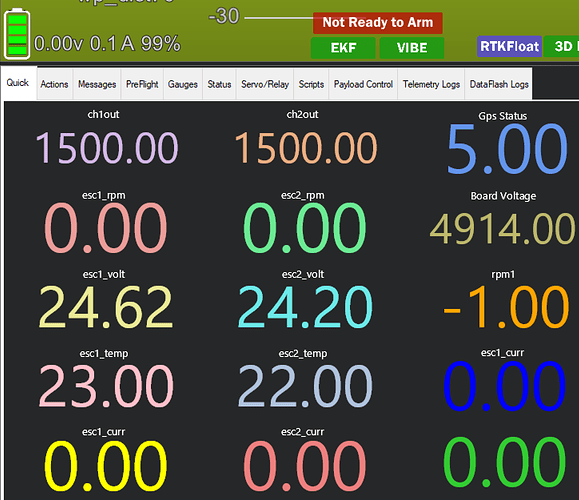and for the sake of documentation -
Ardurover is now 100% for skidsteer with 2x Flipsky 75100 Vesc’s. Forwards/Reverse and turning.
canbus with Y Cable linking 2x VESC to “CAN splitter board” and into the CAN port of th Zealot FC
notes
- update VESC firmware. i used 6.02 75100_100_v2 - easy and quick drama free firmware
- always ensure Filters are turned off in the FOC tab - magic smoke problems elsewise
- set canbus speeds to match - 500K baud eveyrwhere for me
- set Vesc protocol to UAVCAN - there is no dronecan.
- set Vesc can ID to the servo/motor channel to use as ESC i used ID 0 and ID 1
Update: Dont use can Id 0 : telemetry worked initally then stopped - changed to ID 1 and ID2 - set Vesc ESC index to the ESCn numbers in ardupilot i used 0 and 1
- i set the VESC canbus throttle mode to “Duty Cycle” - it seemed to work well
Im away from the mower - so Mission Planner can_ parameters from memory
- CAN_P1_PROTOCOL 1 (dronecan)
- CAN_P1_DRIVER 1 (driver 1 assigned to port 1)
- CAN_D1_UC_NODE bitmask - selecting 0 and 1 as ESC’s
Update: Dont use Id 0 : telemetry worked initally then stopped - changed to ID 1 and ID2 - CAN_D1_UC_ESC_BM bitmask 0 and 1 from memory
- CAN_D1_UC_ESC_RM bitmask 0 and 1
- SERVO1_FUNCTION to 73 (Throttle Left)
- SERVO2_FUNCTION to 74 (Throttle Right)
hints and observations.
I couldnt find much doco around - but setting the canbus ID to 0 and 1 made servo channels 1 and 2 start to work. I spent a bit of time trying how to map ESC1 to Vesc node 47, but thats not how it works.
Update : As above Dont use Can Id 0 as the telemetry stopped working on it for me. I moved to ID 1 and ID 2 and now both telemetry and control work fine.
SLCAN ate and flooded my telemetry bandwidth. Setting it from 1 to 0 restored things.
Definately have your rover off the ground. I had an uncommanded full throttle. On a 300kg mower it would have been a problem if it was on the ground. This is how i found the Vesc’s ESC index is 0 based.
Mission Planner info is good.
zero RPM is correct for ch1out 1500 - mid throttle.
I had odd behaviour with servo (pwm) range extended 950-2050 with 1500 midpoint. Direction of track reversed at full throttle. >2000 . Reset to standard 1000-2000 and all good.
Cheers
